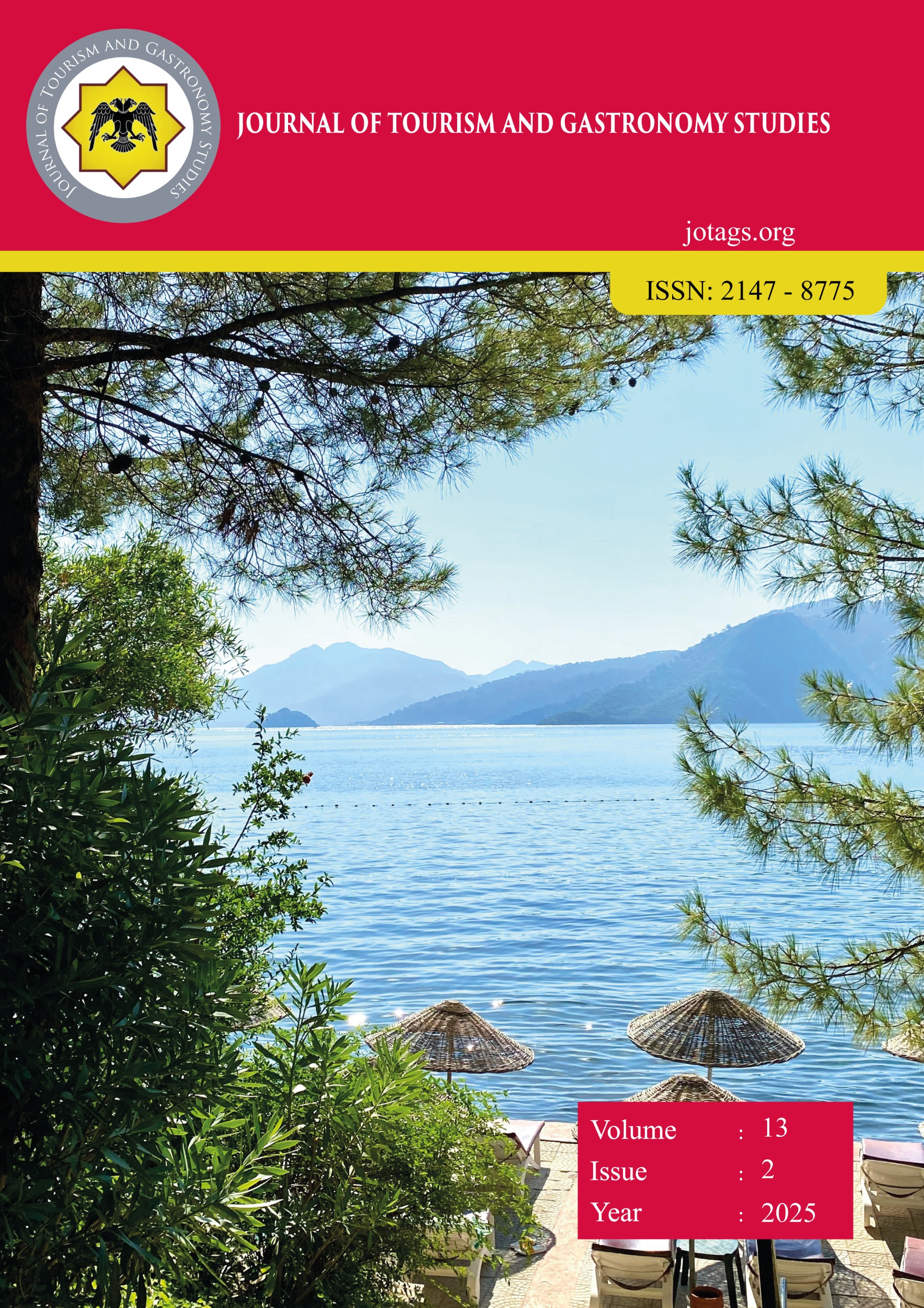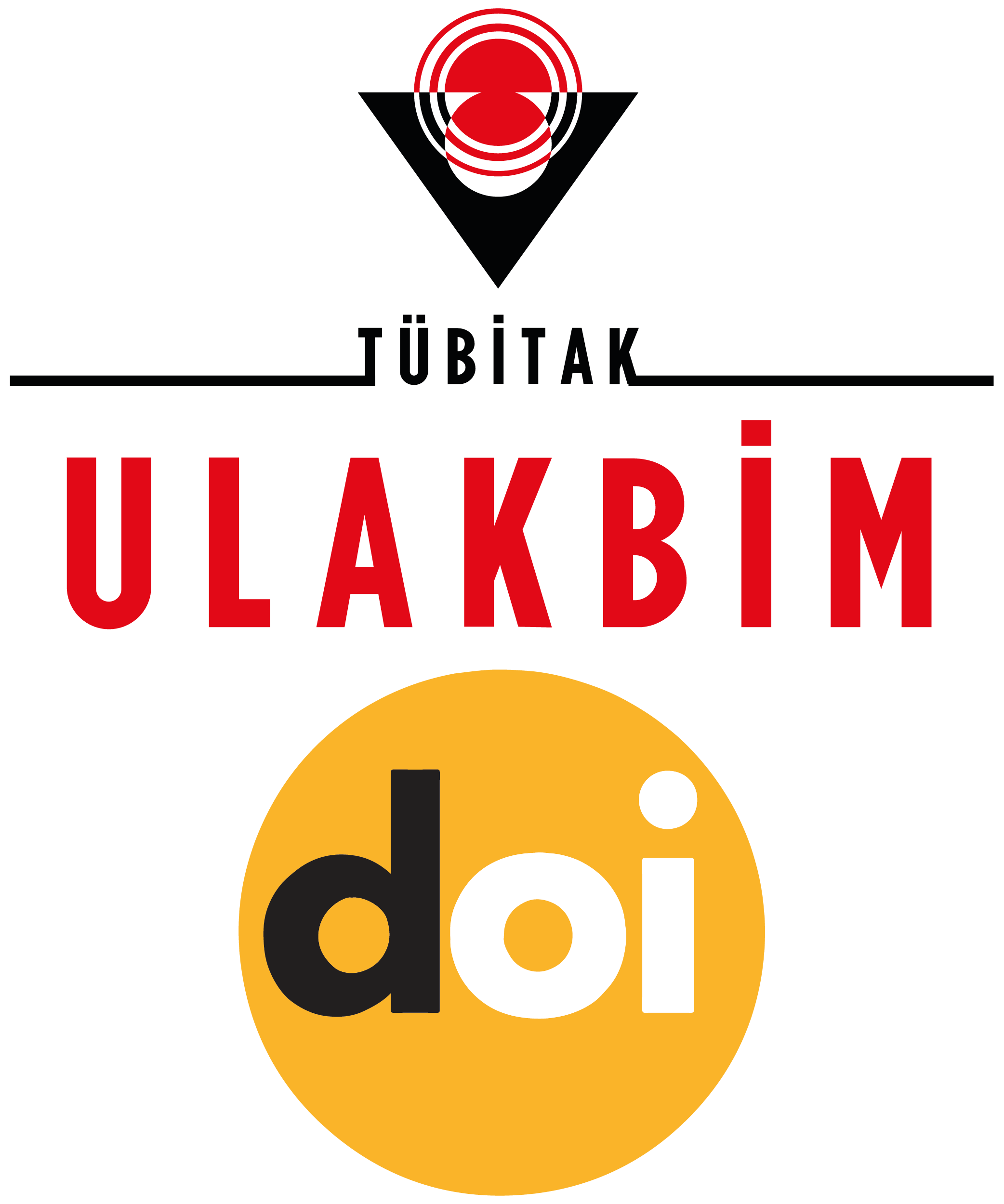6 Şubat Depremleri Sonrası Karanlık (Dark) Turizm Adıyaman İçin Kurtarıcı Olabilir mi? (Can Dark Tourism Be a Salvaging Factor for Adıyaman After the February 6 Earthquakes?)
DOI:
https://doi.org/10.21325/jotags.2025.1650Keywords:
Adıyaman, Earthquake, Dark tourismAbstract
On February 6, 2023, the earthquakes that struck Turkey, described as the disaster of the century, caused serious loss of life and property in 11 provinces. Adıyaman is also among the provinces affected by earthquakes. Before the earthquakes, Adıyaman was considered as a touristic destination within the scope of GAP tours and was in demand for visitors due to its historical, cultural and religious values. In the aftermath of the disaster, the province faced various economic and social difficulties and experienced a significant decline in touristic demand. Based on the idea that diversifying the existing tourism potential can contribute to the economic and social recovery process, the main purpose of the study is to examine whether dark tourism can be a starting point for Adıyaman after the earthquake disaster. In the study, using document analysis technique, one of the qualitative research methods, the impact of the destruction and losses caused by earthquakes on the recovery process within the scope of dark tourism supply is evaluated. In addition, within the framework of dark tourism, recommendations are developed for stakeholders on the effective presentation of possible supply elements in the province.
References
Adıyaman İKTM (2024).
AFAD (2023). 06 Şubat 2023 Pazarcık-Elbistan (Kahramanmaraş) Mw: 7.7 – Mw: 7.6 Depremleri Raporu. 140 s.
Ai, J., Lv, X., & Gursoy, D. (2023). Impact of social media posts on travelers’ attitudes and behaviors towards a destination after a natural disaster: moderating role of the source of the post. Journal of Sustainable Tourism, 31(11), 2460-2478.
Aleffi, C., & Cavicchi, A. (2020). The role of food and culinary heritage for postdisaster recovery: The case of earthquake in the Marche region (Italy). Gastronomy and Tourism, 4(3), 113-128.
Alikhani, E. (2019). Searching for Seeds of Hope Out of the Darkness: The Study of Local Community Perceptions of Post-disaster Tourism in Bam, Iran (Master's thesis, UiT The Arctic University of Norway).
Amujo, O. C., & Otubanjo, O. (2012). Leveraging rebranding of ‘unattractive’nation brands to stimulate post-disaster tourism. Tourist Studies, 12(1), 87-105.
Apuhan, F. (2020). Son yüzyılda Bingöl’de meydana gelen depremler ve etkileri. Bingöl Araştırmaları Dergisi, 6(2), 79-102.
Aral, M., & Tunç, G. (2021). Türkiye’de deprem performansına dayalı bina kimlik bilgilerinin oluşturulmasına yönelik çalışma ve öneriler. Afet ve Risk Dergisi, 4(1), 20-41.
Arıca, R., Arıca, E., & Boğan, E. (2019). Adıyaman’da inanç turizmi açısından önemli bir değer: Sahabe Safvân Bin Muattal. PROCEEDINGS BOOKS, 269.
Ariawan, Z., & Ahmat, N. N. (2020). Expected tourist attractions after pandemic COVID-19. International Journal of Human and Technology Interaction (IJHaTI), 4(1), 107-112.
Arslan, R. (2010). XIX. yüzyılda Adıyaman’da sosyo-ekonomik yapı. Dumlupınar Üniversitesi Sosyal Bilimler Dergisi, 26(1).
Ashworth, G. J., & Isaac, R. K. (2015). Have we illuminated the dark? Shifting perspectives on ‘dark’tourism. Tourism Recreation Research, 40(3), 316-325.
Aydın Özüdoğru, B. A. (2023). 2023 yılında Gerçekleşen Kahramanmaraş Merkezli Depremin Etkileri ve Politika Önerileri. TEPAV: 1- 35.
Balakrishnan Nair, B. (2020). Strategic role of religious tourism in recuperating the Indian tourism sector post-COVID-19. International Journal of Religious Tourism and Pilgrimage, 8(7), 6.
Baran, M. F., Lüle, F., & Gökdoğan, O. (2017). Adıyaman ilinin hayvansal atıklardan elde edilebilecek enerji potansiyeli. Türk Tarım ve Doğa Bilimleri Dergisi, 4(3), 245-249.
Bayhan, Y., Korkmaz, S., & Olgunoğlu, M. (2014). Adıyaman ili balıkçılığının mevcut durumu ve sorunları. Aquaculture Studies, 2014(4), 37-46.
Brown, J. (2013). Dark tourism shops: Selling “dark” and “difficult” products. International Journal of Culture, Tourism and Hospitality Research, 7(3), 272-280.
Buultjens, J. W., Ratnayake, I., & Gnanapala, W. A. C. (2016). Post-Conflict tourism development in Sri Lanka: implications for building resilience. Current Issues in Tourism, 19(4), 355-372.
Cappelli, F., Costantini, V., & Consoli, D. (2021). The trap of climate change-induced “natural” disasters and inequality. Global Environmental Change, 70, 102329.
Ceren, A., & Çelik, S. (2015). Kentsel yoksulluğun çözümünde kamu- sivil toplum kuruluşları işbirliği: Adıyaman Örneği. Adıyaman Üniversitesi Sosyal Bilimler Enstitüsü Dergisi, 8(20), 572-613.
Chan, C. S., Nozu, K., & Cheung, T. O. L. (2020). Tourism and natural disaster management process: perception of tourism stakeholders in the case of Kumamoto earthquake in Japan. Current Issues in Tourism, 23(15), 1864-1885.
Chan, C. S., Nozu, K., & Zhou, Q. (2022). Building destination resilience in the tourism disaster management process from the past experiences: The case of the 2018 Hokkaido Eastern Iburi earthquake in Japan. Tourism Recreation Research, 47(5-6), 527-543.
Chaudhary, M. T., & Piracha, A. (2021). Natural disasters—origins, impacts, management. Encyclopedia, 1(4), 1101-1131.
Coats, A., & Ferguson, S. (2013). Rubbernecking or rejuvenation: Post earthquake perceptions and the implications for business practice in a dark tourism context. Journal of Research for Consumers, 23(1), 32-65.
Çam, O. (2023). Gastronomi turizmi kapsamında adıyaman mutfağının incelenmesi. Turar Turizm ve Araştırma Dergisi, 12(2), 6-44.
Dalmiş, E. (2022). Ortaçağ’da Adıyaman bibliyografyası. Adıyaman Üniversitesi Sosyal Bilimler Enstitüsü Dergisi, 15(40), 405-435.
Estevão, C., & Costa, C. (2020). Natural disaster management in tourist destinations: a systematic literature review. European Journal of Tourism Research, 25(2502), 1-17.
Forgash, R. (2011). Touring Tohoku, serving the nation: Volunteer tourism in post-disaster Japan. The Applied Anthropologist, 31(1), 30-36.
Fountain, J., & Cradock-Henry, N. A. (2020). Recovery, risk and resilience: Post-disaster tourism experiences in Kaikōura, New Zealand. Tourism Management Perspectives, 35, 100695.
Ghimire, H. L. (2016). Tourism in Gorkha: A proposition to revive tourism after devastating earthquakes. Journal of Tourism and Hospitality Education, 6, 67-94.
Göktaş, L. S. (2023). Kahramanmaraş merkezli depremlerin turizm sektörüne etkisi ve deprem sonrası atılması gereken adımlar hakkında öneriler. Journal of Gastronomy, Hospitality and Travel, 6(2), 624-635.
Güncü, A., & Güneş, E. (2017). 1939 Depremi ile afet yeri olan Erzincan’ın hüzün turizmi potansiyeli üzerine bir araştırma. Electronic Turkish Studies, 12(29), 251-270.
Güven, B., & Kaygın, E. (2015). Adıyaman ili SWOT analizi. İstanbul: Veritas Akademi.
Huang, J. H., & Min, J. C. (2002). Earthquake devastation and recovery in tourism: The Taiwan case. Tourism Management, 23(2), 145-154.
Huang, Y. C., Tseng, Y. P., & Petrick, J. F. (2008). Crisis management planning to restore tourism after disasters: A case study from Taiwan. Journal of Travel & Tourism Marketing, 23(2-4), 203-221.
Huang, L., Yin, X., Yang, Y., Luo, M., & Huang, S. S. (2020). “Blessing in disguise”: The impact of the Wenchuan earthquake on inbound tourist arrivals in Sichuan, China. Journal of Hospitality and Tourism Management, 42, 58-66.
Hyde, K. F., & Harman, S. (2011). Motives for a secular pilgrimage to the Gallipoli battlefields. Tourism Management, 32(6), 1343-1351.
Işık, E., Avcil, F., Arkan, E., Büyüksaraç, A., İzol, R., & Topalan, M. (2023). Structural damage evaluation of mosques and minarets in Adıyaman due to the 06 February 2023 Kahramanmaraş earthquakes. Engineering Failure Analysis, 151, 107345.
Iwashita, C. (2006). Media representation of the UK as a destination for Japanese tourists: Popular culture and tourism. Tourist Studies, 6(1), 59-77.
Ivanov, M. L., & Chow, W. K. (2023, December). Structural damage observed in reinforced concrete buildings in Adiyaman during the 2023 Turkiye Kahramanmaras earthquakes. Structures (Vol. 58, p. 105578), 1-18.
İşçi, P. (2008). Deprem Nedir ve Nasıl Korunuruz?. Journal of Yasar University, 3(9), 959-983.
Jiang, Y., Ritchie, B. W., & Verreynne, M. L. (2021). Developing disaster resilience: A processual and reflective approach. Tourism Management, 87, 104374.
Jin, X. C., Qu, M., & Bao, J. (2019). Impact of crisis events on Chinese outbound tourist flow: A framework for post-events growth. Tourism Management, 74, 334-344.
Karademir, N. (2023). Yaratıcı turizm uygulamaları ile Andırın'da deprem yaralarını sarabiliriz. Kahramanmaraş Sütçü İmam Üniversitesi Sosyal Bilimler Dergisi, 20(3), 1006-1020.
Khurana, R., Mugabe, D., & Etienne, X. L. (2022). Climate change, natural disasters, and institutional integrity. World Development, 157, 105931.
Krichen, M., Abdalzaher, M. S., Elwekeil, M., & Fouda, M. M. (2024). Managing natural disasters: An analysis of technological advancements, opportunities, and challenges. Internet of Things and Cyber-Physical Systems, 4, 99-109.
Kužnik, L. (2015). Typology of dark tourism heritage with its implications on Slovenian future dark tourism products. Josef Rojík, 12, 308-317.
Lin, Y., Kelemen, M., & Tresidder, R. (2018). Post-disaster tourism: building resilience through community-led approaches in the aftermath of the 2011 disasters in Japan. Journal of Sustainable Tourism, 26(10), 1766-1783.
Liu-Lastres, B., Mariska, D., Tan, X., & Ying, T. (2020). Can post-disaster tourism development improve destination livelihoods? A case study of Aceh, Indonesia. Journal of Destination Marketing & Management, 18, 100510.
McDaniel, K. N. (2019). The Palgrave handbook of dark tourism studies, Journal of Tourism History, 1-3.
Min, J., Yang, K., & Thapa-Magar, A. (2021). Dark tourism segmentation by tourists' motivations for visiting earthquake sites in Nepal: implications for dark tourism. Asia Pacific Journal of Tourism Research, 26(8), 866-878.
Pearlman, D., & Melnik, O. (2008). Hurricane Katrina's effect on the perception of New Orleans leisure tourists. Journal of Travel & Tourism Marketing, 25(1), 58-67.
Pennington-Gray, L., & Pizam, A. (2011). Destination crisis management. In Destination marketing and management: theories and applications (pp. 314-325). Wallingford UK: CABI.
Peters, M., & Pikkemaat, B. (2006). Crisis management in Alpine winter sports resorts- the 1999 avalanche disaster in Tyrol. Journal of Travel & Tourism Marketing, 19(2-3), 9-20.
Pezzullo, P. C. (2009). “This is the only tour that sells”: Tourism, disaster, and national identity in New Orleans. Journal of Tourism and Cultural Change, 7(2), 99-114.
Putra, I. N. D., & Hitchcock, M. (2006). The Bali bombs and the tourism development cycle. Progress in Development Studies, 6(2), 157-166.
Ritchie, B. W. (2004). Chaos, crises and disasters: a strategic approach to crisis management in the tourism industry. Tourism Management, 25(6), 669-683.
Ritchie, B. (2008). Tourism disaster planning and management: From response and recovery to reduction and readiness. Current Issues in Tourism, 11(4), 315-348.
Rosselló, J., Becken, S., & Santana-Gallego, M. (2020). The effects of natural disasters on international tourism: A global analysis. Tourism Management, 79, 104080.
Rucińska, D. (2016). Natural disaster tourism as a type of dark tourism. International Journal of Humanities and Social Sciences, 10(5), 1458-1462.
Rucińska, D., & Lechowicz, M. (2014). Natural hazard and disaster tourism. Miscellanea Geographica, 18(1), 17-25.
Ryan, C. (2006). Dark Tourism—An Introduction. In Taking Tourism to the Limits (pp. 187-190). Routledge.
Scott, N., Laws, E., & Prideaux, B. (2008). Tourism crises and marketing recovery strategies. Journal of Travel & Tourism Marketing, 23(2-4), 1-13.
Seaton, A. V. (1996). Guided by the dark: From thanatopsis to thanatourism. International Journal of Heritage Studies, 2(4), 234-244.
Seaton, T. (2009). Purposeful otherness: Approaches to the management of thanatourism. The Darker Side of Travel: The Theory and Practice Of Dark Tourism, 75-108.
Sezik, M. (2024). 6 Şubat Depremlerinin Adıyaman Kent Kimliğine Etkisi. İnönü Üniversitesi Uluslararası Sosyal Bilimler Dergisi, 13(2), 418-440.
Sharpley, R. (2006). Travels to The Edge Of Darkness: Towards A Typology of “Dark Tourism”. In Taking tourism to the limits (pp. 215-228). Routledge.
Smith, N. & Croy, W. G. (2006). Presentation of dark tourism: Te Wairoa, the buried village. In Taking Tourism to the Limits (pp. 199-213). Routledge.
Soyluk, A., & Demircan, B. (2023). Tarihi yığma minarelerin deprem yükü altındaki davranışlarının 6 şubat Kahramanmaraş depremlerinde hasar görmüş cami örnekleri üzerinden mimari açıdan incelenmesi. Journal of Architectural Sciences and Applications, 8(Special Issue), 329-354.
Stone, P. R. (2006). A dark tourism spectrum: Towards a typology of death and macabre related tourist sites, attractions and exhibitions. Tourism: An International Interdisciplinary Journal, 54(2), 145-160.
Susanto, J. A. X., & Sushartami, W. (2020). Wong Ndhuwur, Wong Ngisor: Local community and post-disaster tourism in Kinahrejo. Humaniora, 32(3), 271-282.
Tang, Y. (2014). Dark touristic perception: Motivation, experience and benefits interpreted from the visit to seismic memorial sites in Sichuan province. Journal of Mountain Science, 11, 1326-1341.
Tang, Y. (2018). Dark tourism to seismic memorial sites. The Palgrave Handbook of Dark Tourism Studies, 423-441.
Taştemir, M. (1992). “Besni”. DİA. (V, 540-543). Ankara: TDV Yayınları.
T.C. Cumhurbaşkanlığı Strateji ve Bütçe Başkanlığı (2023). Kahramanmaraş ve Hatay depremleri raporu. Strateji ve Bütçe Başkanlığı.
TMMOB (2023). 6 Şubat 2023 Depremlerinin Birinci Yılı Değerlendirmesi.
TMMOB (Temmuz 2023). 6 Şubat 2023 Kahramanmaraş Depremleri Raporu.
Toker, A., & Unat, R. (2024). Kente karşı işlenen suçlar bağlamında Grand İsias Otel örneği: Otellerin güvenliğini yeniden düşünmek. Anatolia: Turizm Araştırmaları Dergisi, 35(1), 74-93.
Ukav, İ. (2014). Adıyaman ilinde kırsal turizm potansiyeli ve geliştirme fırsatları. Elektronik Sosyal Bilimler Dergisi, 13(51).
Walters, G. & Mair, J. (2012). The effectiveness of post-disaster recovery marketing messages—The case of the 2009 Australian bushfires. Journal of Travel & Tourism Marketing, 29(1), 87-103.
Yıldız, S., & Zaman, S. (2024). Adıyaman ilinin kanyon turizm potansiyeli ve planlama önerileri. Route Educational & Social Science Journal, 11(4), 195- 209.
Zhang, Y. (2021). Unpacking visitors' experiences at dark tourism sites of natural disasters. Tourism Management Perspectives, 40, 100880.
Zhang, J., & Cheng, L. (2023). Post-disaster tourism development and scenario planning for the quality of life of residents. Tourism Review, 78(3), 907-926.
Zhang, M., Seyler, B. C., Di, B., Wang, Y., & Tang, Y. (2021). Impact of earthquakes on natural area-driven tourism: Case study of China's Jiuzhaigou National Scenic Spot. International Journal of Disaster Risk Reduction, 58, 102216.
https://www.aa.com.tr/tr/asrin-felaketi/adiyamanin-en-onemli-tarihi-varliklari-depremlerde-hasar-gormedi/2849156#:~:text=Kahramanmara%C5%9F%20merkezli%206%20%C5%9Eubat'taki,Antik%20Kenti%20afette%20zarara%20u%C4%9Framad%C4%B1. Erişim Tarihi: 02.02.2025, 20:30.
https://adiyaman.edu.tr/tr/haberler/2024/02/07/adiyaman-universitesi-6-subat-depremlerinde-hayatini-kaybeden-personel-ve-ogrencileri-icin-karanfil-birakma-toreni-duzenledi Erişim Tarihi: 29.01.2025, 23:45.
http://www.adiyaman.gov.tr/adiyaman-tarihi Erişim Tarihi: 29.01.2025, 23:00.
https://adiyaman.ktb.gov.tr/TR-61344/cografya.html (1) Erişim Tarihi: 29.01.2025, 22:45.
https://adiyaman.ktb.gov.tr/TR-165833/gezsen-adiyaman.html (2) Erişim Tarihi: 02.02.2025, 19:40.
https://adiyaman.ktb.gov.tr/TR-61350/kultur-ve-tabiat-varliklari.html (3) Erişim Tarihi: 03.02.2025, 22:40.
https://www.akdenizgercek.com.tr/adiyamanda-deprem-sonrasi-kulturel-miras-restorasyonu-hizla-ilerliyor Erişim Tarihi: 02.02.2025, 21:00.
https://www.bbc.com/turkce/articles/cj49lyjy1g5o Erişim Tarihi: 03.02.2025, 22:15.
https://www.birgun.net/haber/65-kisinin-oldugu-sueda-kent-sitesi-dosyasinda-tutuklu-sanik-yok-551355 Erişim Tarihi: 03.02.2025, 23:15.
https://deprem.afad.gov.tr/event-statistics Erişim Tarihi: 23.01.2025, 21:40.
https://dosim.ktb.gov.tr/TR-218145/unesco-dunya-miras-listesinde-turkiye.html Erişim Tarihi: 29.01.2025, 23:15.
https://www.gazeteduvar.com.tr/adiyamanda-depremde-yikilan-sansel-sitesinin-muteahhidi-tutuklandi-haber-1610789 Erişim Tarihi: 03.02.2025, 23:55.
https://www.icisleri.gov.tr/turkiyenin-birlik-ve-dayanisma-gucu-depremle-sinandi-asrin-felaketi-asrin-dayanismasina-donustu8#:~:text=Depremin%20s%C3%BCresinin%2065%20saniye%20oldu%C4%9Funu,107%20bin%20213%20vatanda%C5%9F%C4%B1m%C4%B1z%20yaraland%C4%B1. Erişim Tarihi: 20.01.2025, 19:40.
https://www.iha.com.tr/adiyaman-haberleri/adiyamanda-26-eser-depremde-zarar-gordu-55057071. Erişim Tarihi: 02.02.2025, 20:45.
https://www.kulturportali.gov.tr/turkiye/adiyaman/gezilecekyer/ulu-cami553357 Erişim Tarihi: 03.02.2025, 21:04.
https://kvmgm.ktb.gov.tr/TR-44428/nemrut-dagi-adiyaman---kahta.html Erişim Tarihi: 20.01.2025, 20:20.
https://www.milliyet.com.tr/gundem/zumrut-apartmani-37-kisiye-mezar-oldu-ilk-durusmada-sok-savunma-7086338 Erişim Tarihi: 03.02.2025, 23:40.
https://www.tmmob.org.tr/icerik/tmmob-6-subat-depremleri-8-ay-degerlendirme-raporu-yayimlandi Erişim Tarihi: 20.01.2025, 19:30.
https://tyap.net/depremden-etkilenen-illerin-sosyoekonomik-yapisi Erişim Tarihi: 26.01.2025, 18:00.
https://whc.unesco.org/en/list/448/ Erişim Tarihi: 08.02.2025, 20:20.
https://tr.wikipedia.org/wiki/2023_Kahramanmara%C5%9F_depremlerindeki_kay%C4%B1plar Erişim Tarihi: 03.02.2025, 22:00.
https://www.voaturkce.com/a/adiyamanda-depremin-yok-ettigi-belde/7023251.html Erişim Tarihi: 03.02.2025, 21:40.
Downloads
Published
How to Cite
Issue
Section
License
Copyright (c) 2025 Journal of Tourism & Gastronomy Studies

This work is licensed under a Creative Commons Attribution-NonCommercial 4.0 International License.








